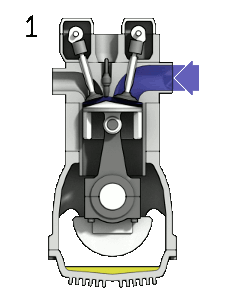Internal combustion engine
Internal combustion engines are the most common form of heat engines, as they are used in vehicles, boats, ships, airplanes, and trains. They are named as such because the fuel is ignited in order to do work inside the engine.[1] The same fuel and air mixture is then emitted as exhaust. This can be done using a piston (called a reciprocating engine), or with a turbine.
The ideal gas law
Internal combustion heat engines work on the principle of the ideal gas law: . Raising the temperature of a gas increases the pressure that makes the gas want to expand.[1] An internal combustion engine has a chamber, which has fuel added to it which ignites in order to raise the temperature of the gas.
When heat is added to the system, it forces gas inside to expand. With a piston engine, this causes the piston to rise (see Figure 2), and with a gas turbine, the hot air is forced into the turbine chamber, turning the turbine (Figure 1). By attaching the piston or turbine to a camshaft, the engine is able to convert a portion of the energy input to the system into useful work.[2] To compress the piston in an intermittent combustion engine, the engine exhausts the gas. A heat sink is then used to keep the system running at a consistent temperature. A gas turbine, which uses continuous combustion, simply exhausts its gas continuously rather than in a cycle.
Pistons vs turbines


An engine that uses a piston is called an intermittent combustion engine, whereas one that uses a turbine is called a continuous combustion engine. The difference in mechanics is obvious due to the names, but difference in use is less obvious.
A piston engine is extremely responsive, in comparison to a turbine, as well as more fuel-efficient at low outputs. This makes them ideal for use in vehicles, as they also start up more quickly. Conversely, a turbine has superior power-to-weight ratio compared to a piston engine, and its design allows for more reliability at continuous high outputs. A turbine also works far better than a naturally-aspirated piston engine at high altitudes and cold temperatures. This light weight, reliability, and high altitude capability makes turbines the engine of choice for airplanes. Turbines are also commonly used at power plants for electrical generation.
Four-stroke engine
While there are many, many kinds of internal combustion engines, the four-stroke piston engine (Figure 2) is one of the most common, used in cars, trucks, and some motorbikes, among other vehicles. A four stroke engines delivers one power stroke for every two cycles of the piston. There is an animation above of a four-stroke engine, and further explanation of the process below.
- Fuel is injected into the chamber.
- The fuel catches fire (this happens differently in a diesel engine than a gasoline engine).
- This fire pushes the piston which is the useful motion.
- The waste chemicals, by volume (or mass) this is mostly water vapour and carbon dioxide. There can be pollutants as well like carbon monoxide from incomplete combustion.
References
- ↑ 1.0 1.1 R. D. Knight, "Heat Engines and Refrigerators" in Physics for Scientists and Engineers: A Strategic Approach, 3nd ed. San Francisco, U.S.A.: Pearson Addison-Wesley, 2008, ch.19, sec.2, pp.530
- ↑ R. A. Hinrichs and M. Kleinbach, "Heat and Work," in Energy: Its Use and the Environment, 5th ed. Toronto, Ont. Canada: Brooks/Cole, 2013, ch.4, pp.93-122
- ↑ Wikimedia Commons [Online], Available: https://upload.wikimedia.org/wikipedia/commons/4/4c/Jet_engine.svg
- ↑ Wikimedia Commons [Online], Available: https://upload.wikimedia.org/wikipedia/commons/d/dc/4StrokeEngine_Ortho_3D_Small.gif

